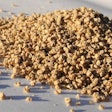
A joint session between the British Association for Animal Science and the United Kingdom (UK) branch of the World's Poultry Science Association (WPSA) focussed on the impacts of the rise in biofuel production on poultry nutrition.
At the same session, Dr Steven Pritchard from the British feed company, Premier Nutrition, discussed the nutritional value of the by-products for poultry. In a paper co-authored by Dr Tom Acamovic of Scottish Agricultural College, he began his presentation with typical feed specifications for poultry in the UK, adding that broiler feeds rarely contain any by-products, while those for layers and turkeys contain only small amounts because of the need to maintain high levels of digestible nutrients for optimum physical and economic performance.
By-products available from bioethanol production in the UK include distillers dried grains with solubles (DDGS), as well as expeller rapeseed meal and glycerol from biodiesel production.
Figure 1: Basic dry-mill bioethanol schematic
By-products from bioethanol
In the general method of producing bioethanol, wheat is the main raw material used in the UK. It comprises 68% starch and 3% sugars, which are used to produce ethanol. Typically, wheat DDGS contains 35% protein, 32% neutral detergent fibre (NDF), 9% sugar and 6% starch.
Of particular concern when considering DDGS as a feed ingredient is the wide variation in nutrient content resulting from the different processing methods and drying conditions employed. The first ethanol plants were designed for the production of the primary product and took no account of DDGS, which resulted in wide variation between batches of the by-product.
Modern plants are more efficient, taking more of the starch and sugars and providing a more consistent by-product. Better understanding and technology have also improved drying procedure so that less of the amino acid content is destroyed and the digestibility of amino acids in the by-products can be better utilised by poultry.
The actual composition of DDGS is affected by a large number of factors and every plant produces a different product.
Analysis of wheat DDGS samples confirms the variation in amino acid content, with first-limiting amino acid, lysine, showing particularly large differences between samples. Variability in maize DDGS samples in the USA is generally assessed by colour as a dark colour indicates overheating and a loss of amino acids. Studies have shown colour to be quite a reliable indicator of maize DDGS quality, but the same work is still to be done for wheat DDGS.
In practical use, wheat DDGS may exacerbate wet litter problems, particularly in the winter, and any mycotoxins present in the wheat will be concentrated in by-products. These may be up to three times higher in the by-product than in the original material. Both mycotoxin binders and feed enzymes may help to improve the feeding value of DDGS.
Biodiesel by-products
Along with imported oilseeds and a range of waste oils, rapeseed offers the greatest potential as a crop for the production of biodiesel in temperate regions such as northern Europe.
Again, processing temperatures and times lead to variation in feeding value for poultry and livestock.
The oil is removed from the seeds either by extraction or expeller methods, which can affect the nutrients in the by-product. It is also important to ascertain the variety of rapeseed as the original plants contained anti-nutritive factors erucic acid and glucosinolates, which made them unsuitable for poultry feeding. Plant breeders have greatly reduced the levels of these toxins in modern double-zero' rapeseed varieties.
Another by-product from biodiesel production is glycerol (also know as glycerin). It can make a useful contribution to poultry diets at levels of around 5% for broilers, layers and turkeys.
Energy value declines at higher inclusion levels, and the high potassium level may upset the electrolyte balance if not considered in the diet formulation.
As with DDGS, glycerol has good potential as a feed ingredient for poultry, providing that variability and possible anti-nutritive factors are taken into account.






